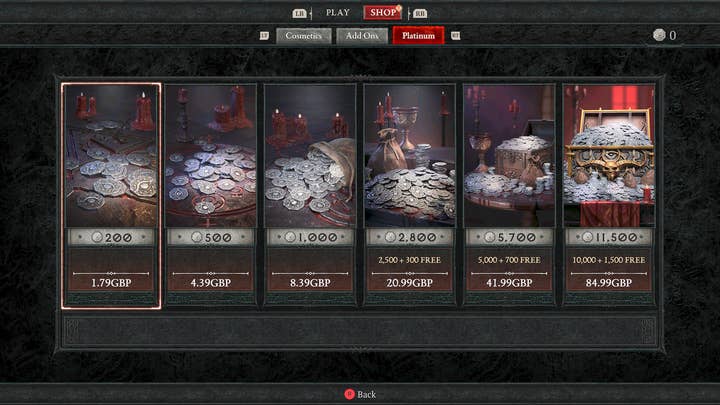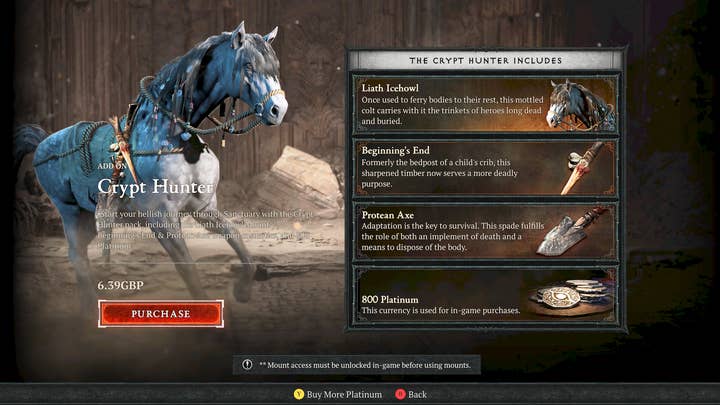In defence of the cosmetic whales | Opinion
Expensive in-game cosmetic items are a contentious issue that many developers tiptoe around – but this is the most balanced and palatable option for a modern business model
Sign up for the GI Daily here to get the biggest news straight to your inbox
On the whole, Diablo 4 has had an incredibly positive response. People like the visuals, the storytelling, and the gameplay, and there’s a strong sense that the series is back on track after the ill-judged (at least from the perspective of long-time fans) Diablo Immortal mobile title.
The reviews are positive, the community is mostly happy – there’s just one fly in the ointment, it seems. That’s the existence of a single tab in the game’s menus, 'Shop', wherein you’ll find a set of cosmetic items (armour, mounts, and the likes) that the game is happy to sell you for between $10 and $20 a pop. There’s some lovely, well-designed stuff in there, but without forking over the cash, you can look but you can’t touch – dressing your character up in those fancy duds demands a surcharge over the full-price game you just bought.
Nobody seems terribly happy about this. There are plenty of articles and forum threads about it; some enterprising person on Reddit figured out that buying all the cosmetics Diablo 4 offers on day one would set you back well over $300, more than five times the price of the base game itself.
The whole situation is spiced up a little by the fact that reviewers weren’t given access to the in-game store prior to launch, so they couldn’t include any assessment of the store and its pricing in their conclusions. The reasoning for that isn’t entirely unfair, in that all the items in the store are purely cosmetic and don’t impact gameplay, so you could argue that they ought not to change how the game is reviewed.
This decision speaks to the developers wanting very much to focus attention away from the whole question of in-game item purchases and pricing
Still, that situation has contributed to a sense that the store’s pricing is something sneaky that has been slipped into the game without anyone getting a chance to scrutinise it before making a buying decision.
I don’t think this is a case of being sneaky – we’ve known that the cosmetics store would be a part of the game for ages – but I do think this decision speaks to the developers wanting very much to focus attention away from the whole question of in-game item purchases and pricing.
It’s not like technical problems with putting the store online pre-launch should have stopped them from giving reviewers this information if they wanted to – simply knocking out a PDF with screenshots, descriptions, and item prices would have been a fair solution. But developers in general feel a bit caught between a rock and a hard place with regard to this kind of commercial aspect in their games.
A cosmetic-only in-game store arguably meets most of the demands and addresses most of the concerns people initially had about the adoption of F2P-style business models, but these stores are still loudly despised – inspiring people to throw around words like "greedy" and "rip-off" – while also seemingly being commercially successful enough to overcome fears of any such backlash.
Trapped between those realities, you can forgive developers for just wanting to keep quiet about this whole aspect – especially a developer like Blizzard, which was dragged over the coals for its in-game transaction systems in Diablo 3, and more recently faced a backlash to similarly pricey player skins in Overwatch 2.
That’s the thing: it’s not like anyone making the decision to include this store, with these prices, was doing so unaware of how a vocal group of consumers and commentators would respond. Blizzard, of all companies, knew it was going to get bashed for selling items in-game, especially expensive items.
Just for once, I’d like to see a developer really step forward to make a full-throated defence of this business model
Hell, reaching back into the depths of video game controversies past, one of the categories of items Diablo 4 will happily sell you is actual honest-to-god horse armour: it’s not like they’re even trying especially hard to avoid being dunked on for their choices here. They were probably resigned to this response, but they clearly didn’t feel the need to draw focus to this aspect either.
This is actually a shame, because just for once, I’d like to see a developer really step forward to make a full-throated defence of this business model. This approach is becoming the dominant paradigm for a lot of different games, with many developers of successful games settling on an in-game cosmetic store with $10 to $20 price points for virtual items as a key part of their business model.
Fortnite does it (it has one of the most extensive item stores, in which buying all the skins would set you back tens of thousands of dollars), Call of Duty does it, Destiny does it, and of course Overwatch and now Diablo do it, to name but a few. Charging people a fair chunk of change for a cosmetic item has become incredibly common, but the negative reaction to almost any kind of in-game transaction model has meant that we reached this point with little proper discussion, debate, or defence of the decisions which led us here.

Yet this model deserves a defence, because in almost every way it’s the least problematic option available – and while it’s never going to make people feel happy when they see a character skin that costs more than $20 (a third the price of the game itself!), it should at least mollify them to know that every other path video game monetisation might have gone down was far, far worse.
Selling cosmetic items only, albeit at a premium, is a far less obnoxious approach than almost any alternative, from locking up playable content behind paywalls, via play-to-win item sales, through to the grifters’ favourite du jour, play-to-earn cryptocurrency-based models.
Most developers have embraced the idea that players should be able to fully enjoy the entire experience of the game without ever paying for any kind of in-game purchase (not all, though, with Blizzard itself arguably tripping up by locking new hero characters behind its premium Battle Pass in Overwatch 2, for example), but the flipside is that players who do decide to buy optional cosmetics end up paying a lot for the privilege.
Selling cosmetic items only, albeit at a premium, is a far less obnoxious approach than almost any alternative
Much of the anger that this generates from players focuses on the seeming imbalance between the price for a cosmetic skin and the price for entire games. The fact that a cosmetic item for a game is priced at a level that will easily buy you a high-quality indie game (or an older AAA title) in its entirety, or net you a couple of months of Game Pass, does make the cost of these items look faintly ridiculous.
But market economics sets prices according to what people are willing to pay, not what makes logical sense based on production costs. All of these games have not set their prices at similar levels just because their business model designers are copying each other’s homework; nor did some scheming executive just pick out a ludicrously high price point while cackling maniacally in a boardroom somewhere.
This pricing convergence happened because after a long process of testing, this turned out to be the price point that maximises revenue from cosmetic items; this is the price that sits on the sweet spot where the demand and price curves intersect.
That shouldn’t be surprising – it makes sense that higher-priced cosmetics would spur demand rather than suppressing it. Many people who dislike the pricing argue that if the items were cheaper, more people would buy them, and the game would make more money – but that’s clearly not the case. In fact, the value of cosmetic items lies partially in their rarity, and in the fact that not everyone has them, or has been willing to pay for them.
Owning a cosmetic most people don’t have is a flex; it makes your character a little bit unique, and for many players, there’s real value in that. If the price dropped and more people could buy the cosmetic, it would open it up to new audiences – but would also decrease the appeal of the item itself, which no longer felt rare or premium. Skins and other cosmetics are luxury items, not commodities; you could quite easily find yourself dropping item prices only to find that it actually decreases demand, rather than increasing it.
This brings me back around to why I want a developer to actually take the bit between their teeth and make the case for this model properly. The business model itself is grounded in commercial data and testing over the long term – it’s not some wild idea cooked up lately by "greedy" developers daydreaming about filling Scrooge McDuck’s swimming pool with the revenues from selling FPS game skins.
Rather, it’s the best way we’ve come up with so far to generate solid additive revenues from games without ruining the experience for those who can’t or won’t pay for the extra items. That’s not optional bonus revenue – it’s a crucial part of the business model, because absent the ability to generate additional revenue after launch, the economics of developing and selling games have never been tougher.
We don’t have to love the existence of cosmetic whales, but we can appreciate that the model works, does little harm, and has kept the industry away from far less consumer-friendly solutions
It may not feel like it in the current economic climate, but games have never been cheaper (adjusted for inflation, games are still much cheaper right now than at any point in the 1990s or 2000s) while the cost of development, and of meeting players’ skyrocketing expectations, has never been higher.
That’s why the discussion of business models needs to happen, and the fantasy that games would be just fine and dandy if they were sold at $60 and never made a cent afterwards needs to be deflated. If games were priced now as they were in the PS1 and PS2 eras, they would cost around $100, inflation-adjusted; SNES-era titles topped $120 to $140 in today’s money. That’s not even allowing for the massive increase in the cost of creating them, or the huge amount of high-fidelity content and assets, fully voice acted with an orchestral score and cinematic cutscenes, that consumers now expect from top-tier titles.
Nobody wants $100 games, let alone $120 or more – not consumers and not the industry. Given which, is it not a wonderful thing that those costs can instead be offset by selling some totally optional shiny virtual clothing to the minority of people who love the game enough to be willing to pay a premium for that? The other possibilities suggested by the rise of F2P models were a far darker timeline; we don’t have to love the existence of cosmetic whales, but we can at least appreciate that the model works, does little harm, and has kept the industry away from far less consumer-friendly solutions to its very real economic dilemma.
Sign up for the GI Daily here to get the biggest news straight to your inbox




